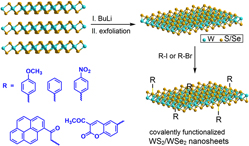Crossref Citations
This article has been cited by the following publications. This list is generated based on data provided by
Crossref.
Rohaizad, Nasuha
Mayorga-Martinez, Carmen C.
Sofer, Zdeněk
and
Pumera, Martin
2017.
1T-Phase Transition Metal Dichalcogenides (MoS2, MoSe2, WS2, and WSe2) with Fast Heterogeneous Electron Transfer: Application on Second-Generation Enzyme-Based Biosensor.
ACS Applied Materials & Interfaces,
Vol. 9,
Issue. 46,
p.
40697.
Vishnoi, Pratap
Fatahi, Parvin
Barua, Manaswee
Bandyopadhyay, Arkamita
Pati, Swapan K.
and
Rao, C. N. R.
2018.
Covalently Functionalized Nanoparticles of Semiconducting Metal Chalcogenides and Their Attributes.
ChemNanoMat,
Vol. 4,
Issue. 1,
p.
41.
Manjunatha, S.
Machappa, T.
Sunilkumar, A.
and
Ravikiran, Y. T.
2018.
Tungsten disulfide: an efficient material in enhancement of AC conductivity and dielectric properties of polyaniline.
Journal of Materials Science: Materials in Electronics,
Vol. 29,
Issue. 13,
p.
11581.
Huang, Yu Li
Zheng, Yu Jie
Song, Zhibo
Chi, Dongzhi
Wee, Andrew T. S.
and
Quek, Su Ying
2018.
The organic–2D transition metal dichalcogenide heterointerface.
Chemical Society Reviews,
Vol. 47,
Issue. 9,
p.
3241.
Manjunatha, S.
Chethan, B.
Ravikiran, Y. T.
and
Machappa, T.
2018.
Room temperature humidity sensor based on polyaniline-tungsten disulfide composite.
Vol. 1953,
Issue. ,
p.
030096.
Manjunatha, S.
Kumar, A. Sunil
and
Machappa, T.
2018.
Dispersions of TiS2 nanosheets in organic medium.
Vol. 1953,
Issue. ,
p.
030019.
Vishnoi, Pratap
Pramoda, K.
and
Rao, C. N. R.
2019.
2D Elemental Nanomaterials Beyond Graphene.
ChemNanoMat,
Vol. 5,
Issue. 9,
p.
1062.
Sunilkumar, A
Manjunatha, S
Machappa, T
Chethan, B
and
Ravikiran, Y T
2019.
A tungsten disulphide–polypyrrole composite-based humidity sensor at room temperature.
Bulletin of Materials Science,
Vol. 42,
Issue. 6,
Manjunatha, S.
Machappa, T.
Ravikiran, Y. T.
Chethan, B.
and
Revanasiddappa, M.
2019.
Room temperature humidity sensing performance of polyaniline–holmium oxide composite.
Applied Physics A,
Vol. 125,
Issue. 5,
Sunilkumar, A.
Manjunatha, S.
Chethan, B.
Ravikiran, Y.T.
and
Machappa, T.
2019.
Polypyrrole–Tantalum disulfide composite: An efficient material for fabrication of room temperature operable humidity sensor.
Sensors and Actuators A: Physical,
Vol. 298,
Issue. ,
p.
111593.
Li, Duo O.
Gilliam, Matthew S.
Chu, Ximo S.
Yousaf, Ahmed
Guo, Yuqi
Green, Alexander A.
and
Wang, Qing Hua
2019.
Covalent chemical functionalization of semiconducting layered chalcogenide nanosheets.
Molecular Systems Design & Engineering,
Vol. 4,
Issue. 4,
p.
962.
Manjunatha, S.
Machappa, T.
Ravikiran, Y.T.
Chethan, B.
and
Sunilkumar, A.
2019.
Polyaniline based stable humidity sensor operable at room temperature.
Physica B: Condensed Matter,
Vol. 561,
Issue. ,
p.
170.
Manjunatha, S.
Ravikiran, Y. T.
Chethan, B.
Devendrappa, H.
and
Machappa, T.
2020.
Alternating current response studies on polyaniline-neodymium oxide composites.
Vol. 2244,
Issue. ,
p.
080009.
Sunilkumar, A.
Manjunatha, S.
Ravikiran, Y. T.
Devendrappa, H.
and
Machappa, T.
2020.
AC frequency-dependent dielectric studies of polypyrrole composites.
Vol. 2244,
Issue. ,
p.
080005.
Saidu, Femina Kanjirathamthadathil
and
Thomas, George Vazhathara
2020.
Synthesis, characterization and dielectric studies of poly(1-naphthylamine)–tungsten disulphide nanocomposites.
SN Applied Sciences,
Vol. 2,
Issue. 7,
Manjunatha, S.
Chethan, B.
Kumar, A.Sunil
Ravikiran, Y.T.
Revanasiddappa, M.
and
Raghavendra, S. C.
2020.
Tantalum disulfide as Room Temperature Operable Efficient Humidity Sensor.
p.
1.
Manjunatha, S.
Megha, R.
Chethan, B.
Prashantkumar, M.
Ravikiran, Y. T.
and
Machappa, T.
2021.
Structural and AC Electrical Properties of Tantalum Disulfide Embedded Polyaniline Composites.
Journal of Materials Engineering and Performance,
Vol. 30,
Issue. 3,
p.
1885.
Yan, Ellen
Balgley, Renata
Morla, Maureen B.
Kwon, Soonho
Musgrave, Charles B.
Brunschwig, Bruce S.
Goddard, William A.
and
Lewis, Nathan S.
2022.
Experimental and Theoretical Comparison of Potential-dependent Methylation on Chemically Exfoliated WS2 and MoS2.
ACS Applied Materials & Interfaces,
Vol. 14,
Issue. 7,
p.
9744.
Jeong, Jae Hwan
Kang, Sojung
Kim, Namwon
Joshi, Rakesh
and
Lee, Gwan-Hyoung
2022.
Recent trends in covalent functionalization of 2D materials.
Physical Chemistry Chemical Physics,
Vol. 24,
Issue. 18,
p.
10684.
Sunilkumar, A.
Manjunatha, S.
Ravikiran, Y. T.
Revanasiddappa, M.
Prashantkumar, M.
and
Machappa, T.
2022.
AC conductivity and dielectric studies in polypyrrole wrapped tungsten disulphide composites.
Polymer Bulletin,
Vol. 79,
Issue. 3,
p.
1391.
